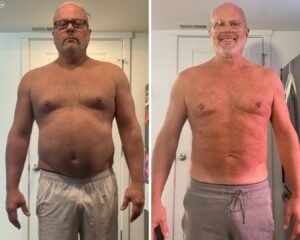Diet and physical activity are the pillars of a healthy life, and we all know it. The problem is that not enough of us are putting the advice into practice. As many as 49.1% of Americans have tried to lose weight, and too few got beyond the planning stage!
Fortunately, creating a low-calorie diet for weight loss is not as hard as you’d think. Let’s talk about how to create a diet plan for your weight loss goals today!
Focus on Nutrition First
We would much rather you lose weight a little more slowly and be healthy than be overly restrictive, unhealthy, and unsafe. It’s important to lose weight safely for the best long-term results. Nutrition should be at the forefront of your mind when creating a diet plan, so think ahead and eat a wide enough variety of foods.
There is no one magical food that can cover all of your nutritional needs. Remember, whole foods first. Generally speaking, we’d recommend eating at least 20 different plant foods every week, regardless of the type of diet you have.
We don’t mean just fruits and vegetables. This includes whole grains, nuts, seeds, legumes, and other plant-based foods. We’re not suggesting veganism unless it’s something you think you could sustain, but a wide variety of these foods is essential for your overall health.
Fortunately, there’s an easy way to achieve a wide variety of nutrients from these foods; color. The color of our whole foods tells us a lot about their nutritional content. Eating a salad, soup, or smoothie is a great way to get a lot of color into your meal, but just take a look at your plate and strive for diversity with each meal!
There are hundreds of different micronutrients that we need to survive, and some of them are hard to get from our meals. Eating a wide variety can help you with overall health (including mental health), fighting off diseases, and promoting proper bodily functions.
Restrictions Second
Now that you understand the importance of eating a wide variety of foods, you can choose a restrictive diet if you want. However, don’t be overly restrictive to the point where you will want to give up in a few days or weeks. Make it sustainable.
When it comes to losing weight, we ideally want to cut out foods that are dense in calories and low in nutrition. Some nuts or nut butters are okay, but eating burgers, hot dogs, and french fries are not. Let’s talk about some of the most popular and heart-healthy diets for weight loss.
Vegetarian Diet
Vegetarians don’t eat meat, and no matter what you hear from your carnivorous friends, this doesn’t put them at any physical disadvantage. Humans are primed to get the majority of their calories from plant foods, and vegetarians can still use some animal products to supplement their nutritional needs.
Vegetarians can still eat eggs and dairy products, and pescatarians can still eat fish. However, they will rely more heavily on plant-based foods, which are far better for a weight loss meal plan than excessive animal products.
Vegan Diet
Vegans don’t eat any animal products at all. Their entire caloric intake comes from plants and occasionally microorganisms like nutritional yeast. No eggs, no dairy, no meat.
If you choose to eat vegan, you’re doing a great favor to animals, the environment, and possibly your health. Vegans are healthier than meat-eaters on average, but only if they are eating the right foods.
On such a restrictive diet, it’s more important than ever to eat a wide variety of plants to cover your nutritional needs. Also, you may need a B12, iodine, or iron supplement, as these are difficult to find in a vegan diet (seaweed is a great vegan source).
Don’t think a wide variety is too important? Prior to agriculture, humans ate over 100,000 different plant species, which covered the vast majority of our calories. Today, over 90% of the calories humans consume come from just 15 crops and nearly half of all calories from only three crops.
Also, try to stay away from fake meats as much as possible. Tofu and tempeh are fine, but some of the heavily processed foods like fake meat products are even less healthy than the real thing. At the very least, read the packaging ahead of time.
Mediterranean Diet
If you want to eat more plant-based foods but can’t give up animal products or meat entirely, then the Mediterranean diet is for you! Essentially since the diet doesn’t impose restrictions on what you can eat but rather general limits or guidelines.
In most cultures around the Mediterranean, they’re known to eat plant foods first and animal products second. Contrast this with the typical American diet, where most meals are centered around meat and other animal products.
For example, a typical Mediterranean dish may use lentils or beans as the primary protein source, tomatoes and greens as the filler, and one egg on top. Olive oil and whole grains like pasta and bread are also very common in these cultures, helping you feel full without overly saturated fats or calorie-dense meats.
Low-Carb Diet
High-fat diets like keto are becoming more popular, and they are controversial topics. However, these are extremely restrictive diets, and one slip can pull you out of ketosis, which is the whole point of the diet. For this reason, we don’t recommend jumping into these before you’ve proven that you can adhere to a program.
Control Your Calorie Intake
Okay, now you’re eating foods from every food group, and you’ve chosen the restrictions you want to place on your diet. Now, we need to talk about adjusting your calorie intake.
First, you need to determine your total daily energy expenditure or TDEE. You can use a TDEE calculator, but it won’t be 100% accurate since everybody is different. However, it will give you a close estimate as a starting point, and you can easily figure out your calorie needs as you go!
If you find that your TDEE is around 2,400 calories, then you’ll want to try to eat between 1,500 and 2,000 each day. Ideally, you’ll aim for 1,900 on average. This way, you’ll lose one to two pounds per week of fat and still have an easy time achieving all of your nutritional requirements.
Control your portion sizes, stop eating when you feel satiated, and consider changing your eating window. Since fat is the most calorie-dense of all of the food groups, try a fat-free diet or at least an oil-free diet. Eating for volume can help you feel full throughout the day.
Fortunately, this is easier than you think if you eat more fruits and vegetables throughout the day. You’d be full long before you ate 300 calories worth of carrots, so try snacking on vegetables more often, especially uncooked vegetables. This is a great way to help you feel full, get some quality nutrition, and lose weight.
Be Consistent With Your Diet Plan
Consistency and adherence are essential. Write down your goals and plans ahead of time for reference and find ways to stay motivated. We are 42% more likely to achieve goals that are written down, so do this ahead of time and keep them handy.
You may feel motivated to overcome challenges now, but you can’t just eat a bunch of vegetables one day and hope to lose weight. It’s an ongoing lifestyle change that gets easier and easier with time. You just have to overcome the initial challenges.
Find a system that works for you and stick to it. Always try to cook meals that you think you’ll enjoy. If you’re not huge on gambling with new recipes, then one of the best ways to do this is to make healthier versions of foods you love!
For example, let’s say you love pizza more than anything. Why not make a homemade pizza with light cheese, plenty of vegetables, and a cauliflower or whole-grain crust? You always have options to choose from.
Also, try to prep your meals ahead of time so that you don’t have to cook every time. It’s hard to find food that fits your diet for weight loss by eating out or grabbing something on the go.
Keep up the Great Work
If you’re even considering a diet plan for weight loss, then you’re already ahead of the game. Developing and implementing a healthy meal plan can be challenging, but the rewards are so worth it for preventing conditions like heart disease and type 2 diabetes and building confidence in your daily life. Get started today to see results as soon as possible!
For more information, keep reading our blog for our latest lifestyle tips, and feel free to contact us with any questions or for help with your plan!






0 Comments